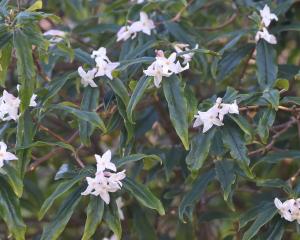Seeing parsnips in a supermarket at $4.99 a kg last month, I did some sums to try to put a dollar value on the row in my garden. The answer made me feel quite wealthy.
As we all know, as fuel prices rise, so does the cost of everything that has to be freighted - and that includes every item of food we buy.
The grim news is that it is not going to get better, but one way of trying to keep down costs is to grow as many vegetables as you can.
You don't need a large area to get started: follow the example of an elderly woman who grows three silverbeet plants each year among the flowers in the minute garden of her pensioner unit.
She says that's enough for her for most of the year.
If you are starting out on a tight budget and don't have tools, look for a fork and spade at garage sales, op shops, auctions or school fairs. Check the handles are not split before buying.
Later, you may wish to add a rake and other tools but for the moment those two implements are enough to get going.
If your ground is too hard to dig easily, don't worry. Use an old knife to cut out perennial weeds, such as dandelions and docks, and put a little salt on the cut stems or pour boiling water on them.
Now lay on the ground a thick layer of old newspapers - about two Saturday editions of the Otago Daily Times is a good depth - or old wool (not synthetic) carpet, with the fuzzy side down.
Water well, then cover that with vege trimmings, lawn clippings, leaves, annual weeds such as chickweed and puha, the contents of the vacuum cleaner bag and a generous quantity of manure.
Sprinkle with lime and some blood and bone (100g to a sq m), or use a commercial fertiliser such as Nitrophoska Blue.
Buy some bags of inexpensive potting mix to spread on your plot, water again and you can start planting.
This no-dig method can also be used on bare ground being turned into a garden for the first time. If your soil is solid clay, gypsum sprinkled on it before putting down the paper helps break up the heavy structure.
Boards around the vege patch, with paths between, make it easier to work.
The question now is what to plant. Most seed-sowing and planting has to wait until October but you can get your new patch under way this month with some hardy veges that don't mind the non-composted mix you've put in and will stand over the winter.
Cabbage and cauliflower are recommended, as is silverbeet. The latter produces steadily over a long period as hand-sized silverbeet leaves can be picked from the outside of the plant and the inner leaves left to develop.
Not as well known is tatsoi (Brassica narinosa or Brassica rapa var. rosularis), also called spinach mustard, spoon mustard, or rosette bok choy.
This Asian vegetable has dark green spoon-shaped leaves which form a thick rosette, takes 45-50 days from sowing to harvest and can withstand temperatures down to minus 9.4degC. Tatsoi can be harvested even from under the snow.
For longevity, though, nothing beats rhubarb. Our garden varieties are descended from plants from the mountains of Turkey and central Asia, whose ground roots were popular almost 4000 years ago among Chinese herbalists.
It was not until the 17th century that rhubarb stems were eaten in Europe and another 100 years before cheaper sugar saw its widespread use in cooking.
The leaves were - and are - an absolute no-no for eating, as they are chock-full of poisonous oxalic acid.
If you put in rhubarb plants now, they won't produce new growth until spring, although they can be sped up by covering them with large, upturned flower pots.
Rhubarb is greedy and needs a good feed of manure every year. There's no need to be sophisticated about it: you can spread a bucket or two of horse or cowpat manure over the plants when the leaves die down at the beginning of winter and not only will it feed the rhubarb but will also help keep weeds down.
Keep your fledgling garden weeded throughout the winter, particularly empty areas, so it will be ready for working over and planting more veges in spring.
If you do not have a compost bin, here's a tip from a Dunedin reader. She fills black garden rubbish bags with compostable materials and when a bag is full, waters the contents, ties the neck firmly and leaves it to cook into usable compost.












